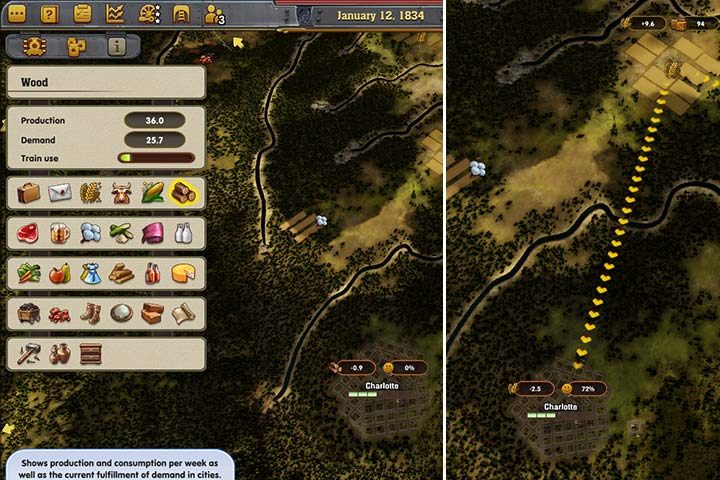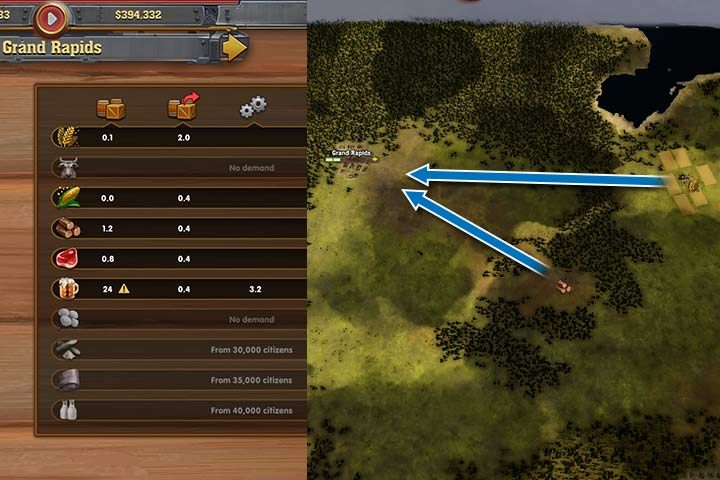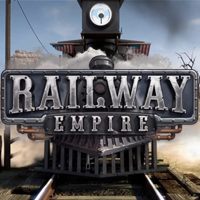Railway Empire: How to develop cities and factories?
Last update:
Urban development is essential during the game. Sometimes it is the purpose of a given scenario, where you have to develop a specific city to a certain level. In addition, the larger cities offer a larger market and open up new opportunities. Urban development is not only useful, but also needed in order to increase the profits of your company. Similarly, in the case of factories and processing plants, the more they produce, the more you can transport and earn.
- Cities develop primarily through the supply of goods and resources
- Goods are delivered to cities in two ways
Cities develop primarily through the supply of goods and resources
Transport of passengers and mail is also important, but does not have as much of an impact. You might as well stop transporting express goods and still be able to develop a city, but you cannot afford to stop the inflow of goods and resources. In every city you can check what products are needed for the purposes of development. The larger the city, the longer the list. Every 5,000 inhabitants unlock another threshold, which will result in a new product, that the residents expect to be supplied. The quantity and variety of goods delivered affect the "fulfillment of demand" factor. If it is greater than 60%, the number of inhabitants will increase. That is why you need a constant stream of supplies to any city.

Goods are delivered to cities in two ways
- If the facility producing resources is close (e.g. a farm that produces grain), then the transport takes place in a traditional way, with wagons and horses. However, it is slow and provides a very small amount of products.
- The second way is to transport resources using trains. It does not necessarily have to be your railway depots. If the rival delivers products to the city, they also reach the general pool and contribute to the development of the city.
- Small housing estates do not have high requirements, so your trains can quickly stop riding with full stores. That is why it is worth combining several cities or several factories with one city. In every city, there is a factory (or one will appear quickly if there is a free slot), so another good move is to connect 2-3 cities to transport products between them.

- At the beginning of most missions, every city always needs grain, corn, wood, (these are resources produced in facilities outside of cities) beer and meat (goods produced in urban processing plants). Cities often have a brewery or a meat processing plant at the beginning of the scenario. These are the basic resources that appear in every city. What is more, you can use, e.g. grain to make beer (one of the basic goods), and wood to make boards (an intermediate good needed for residents and for the production of several goods in subsequent thresholds). In this way, the city and factory will use the same resource, and your network can grow and multiply profits.
- Before you start transporting resources to a given city, check what the demand in that city looks like and how far away the production centers are from this city. If most of the production centers are far away, it is worth changing the location. Sometimes this is not possible, or you are forced to develop a specific city. However, over a larger amount of time, it is definitely worth having one city, where the transport of many products and resources is very easy. Through such a city, you will provide yourself with a good place to sell goods and multiply your funds, which will be needed to achieve the other goals.
- The production of goods works similarly. The factories use traditional means of transport, as well as the railway. However, if their products are not distributed or used in the city, production will halt and they will stop accepting deliveries from the manufactories. You can take advantage of the fact that the rival provides, e.g. grain to the brewery and only deliver beer to other cities yourself. You will, however, be dependent on the supply deliveries of your rival.

- If you intend to focus on a specific city, consider building or purchasing a factory. Sometimes the game facilitates such a decision and puts a factory on an auction, or you will be sent an offer to buy the facility at a lower price. This way, you will earn extra money on transports that you plan on executing anyway. Choose goods that suit the city's needs or choose a factory that has no competition in the area, in order to distribute excess production to nearby towns. If there is a factory in the city that is useless or the production center that it needs is very far away, then you can buy it, destroy it and then construct a more useful facility in its place. It is a very expensive investment, so think twice about this move or save the game before making the decision.
- It is worth noting, that if several stations are within the reach of the factory/production center, the products of these facilities will be distributed evenly between all stations (whether they are your stations or the opponent's). In addition, each company can increase or decrease the number of resources or goods produced. It is enough to maintain a high production efficiency indicator for a long time. If the business belongs to you, you can simply invest money and increase production.

- Building a museum is a helpful solution if you have a problem with maintaining the "fulfillment of demand" indicator of the city's residents. Each city has a special slot for unique structures.
- These can be attractions that will draw in additional passengers or a university that speeds up earning research points. To build such a facility, you must have a station in the city, and the number of inhabitants must exceed the threshold of 60,000. The construction of the Museum raises the "fulfillment of demand" variable by 10%. Residents will accept having a smaller amount of goods and the city will continue to grow.
You are not permitted to copy any image, text or info from this page. This site is not associated with and/or endorsed by the developers and the publishers. All logos and images are copyrighted by their respective owners.
Copyright © 2000 - 2025 Webedia Polska SA for gamepressure.com, unofficial game guides, walkthroughs, secrets, game tips, maps & strategies for top games.
